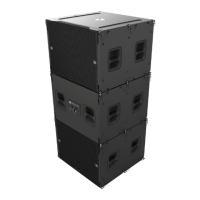28
VTX B18 | User Manual
11.4 - CARDIOID VS OMNI - SPL DIFFERENCES
Its often questioned whether the rear facing subwoofers used for cancellation behind the array are positively contributing to the SPL
produced at the front of the array. In other words, are cardioid stacks lossy, and if all available subwoofers were forward facing, would
that array produce higher SPL?
20 100 1000 10000
Frequency (Hz)
-35
-25
-15
-5
0
3x VTX B18 all forward facing
2:1 Cardioid Array
2x VTX B18 all forward facing
B18 SPL: Cardioid Vs all forward (measurements taken at 10m)
With the prober JBL preset, rear facing subwoofers, not only reject sound at the back of an array, but also positively contribute to the
sound pressure at the front of the array. The contribution is not at the same rate as if all subwoofers were arranged facing forward but,
they do contribute none the less. The curves below show the difference between the three examples shown in the illustration above. The
2:1 cardioid stack, produces marginally less SPL than the all forward stack of 3 (about 1dB) but significantly more SPL than the stack of
2. Therefore any subwoofers used for cancellation are not a loss and do contribute to the overall output of the array.
TIP: The point of maximum rejection of a cardioid stack is about 3 meters (9.8’) behind the array.
2 x Forward Facing B18s 2:1 Cardioid Stack 3 x Forward Facing B18s

